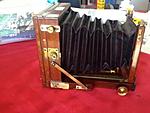and, at the risk of being annoying...here's some other pictures for reference. I took the black paint off the front and this is what is there now. There is a crack in the front piece that someone tried to fix but it's out of whack and sticks out on one side, so I was thinking of just sanding it on one side so it will match. The view from the top is the brass bar without black paint (took a while to get off). The third picture is what the camera looks like generally.



 Reply With Quote
Reply With Quote


Bookmarks